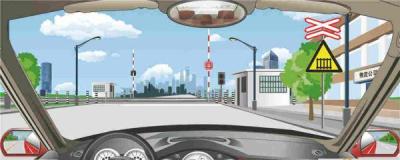1、This sign warns of an intersection of railways and highways ahead.

A、Right
B、Wrong
Answer:A
2、The sign on the right warns of a winding road to the left ahead.

A、Right
B、Wrong
Answer:B
3、The sign on the right warns that there are vehicles converging into the intersection on the right.

A、Right
B、Wrong
Answer:A
4、What should drivers keep in mind when driving on amountainous road?
A、Keep a safe distance
B、Avoid occupancy of another lane when making a turn
C、Downshift in advance when ascending an abrupt slope
D、Taking full advantage of engine braking when descending a long slope
Answer:ABCD
5、When entering an expressway ramp, which of the following statements is correct?
A、Drivers are allowed to overtake other vehicles
B、Drivers are prohibited from making U-turns
C、Drivers are allowed to stop
D、Drivers are allowed to reverse
Answer:B
6、At this moment, the driver may speed up and pass the intersection rapidly.

A、Right
B、Wrong
Answer:B
7、Motor vehicle drivers should rush to the top of the slope in this situation.

A、Right
B、Wrong
Answer:B
8、The sign on the right warns of right-hand S-shaped bend ahead.

A、Right
B、Wrong
Answer:B
9、What should the driver do when a motor vehicle encounters this situation on a mountain road?

A、Stick to respective lanes and speed up to approach each other
B、Drive close to the central line of the road
C、Retain the normal speed
D、Slow down
Answer:D
10、The guide arrow on the road surface of this lane indicates that only U-turns are permitted at the intersection ahead.

A、Right
B、Wrong
Answer:B
11、When rescuing a wounded person who has been poisoned by toxic gas, which of the following measures should be taken first?
A、Prevent heat loss
B、Bring him/her to a place with fresh air
C、Give him/her artificial respiration
D、Depress the heart over the chest
Answer:B
12、The sign on the right indicates that the number of the lanes ahead will increase.

A、Right
B、Wrong
Answer:B
13、What should motor vehicle drivers do when parking temporarily on a rainy day?
A、Turn on hazard lamp
B、Turn on front and back fog lamp
C、Turn on low-beam
D、Set up warning sign at the back of the vehicle
Answer:A
14、Under such circumstances at a congested intersection, what should motor vehicle drivers do?

A、Force the vehicle to go back to its original lane
B、Closely follow the vehicle in front and refuse to yield
C、Politely yield and pass through
D、Sound the horn and turn on the head lamps
Answer:C
15、Mr. Tong drove a large bus(capacity 55 people and carrying 54)to Taiyuan City. When he drove on a muddy road at the speed of 45 kilometers per hour, the bus skidded into a deep ditch, killing 14 people dead and badly injuring 40 What's the main illegal act committed by Mr Tong?
A、Overloaded
B、Speeding
C、Driving after drinking
D、Fatigued driving
Answer:B
16、When running on an expressway with three lanes in each direction, which one of the following lanes is not appropriate for the motor vehicle to use if its speed ranges between 90 kilometers per hour and 110 kilometers per hour?
A、The far left lane
B、The middle lane
C、The far right lane
D、Any lane
Answer:A
17、The sign on the right indicates that the vehicle should yield to the oncoming traffic as approaching each other.

A、Right
B、Wrong
Answer:B
18、The broken white line on the right side of the road indicates that drivers are allowed to change lanes by crossing the line.

A、Right
B、Wrong
Answer:A
19、The sign on the right warns of traffic signals ahead.

A、Right
B、Wrong
Answer:A
20、When encountering such pedestrians while driving, a longer safety distance should be kept by drivers.

A、Right
B、Wrong
Answer:A